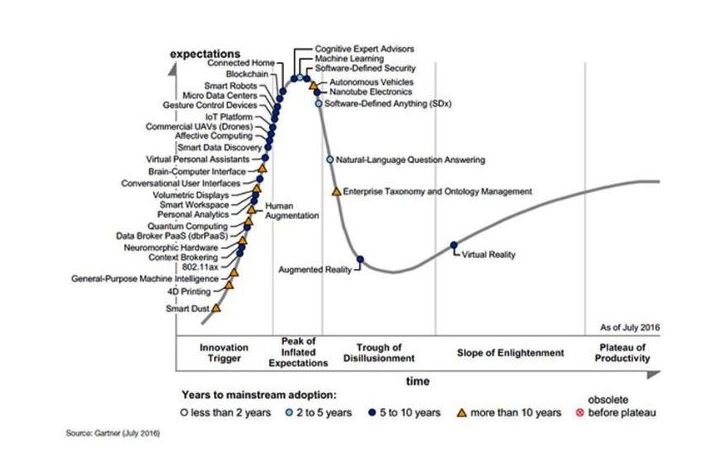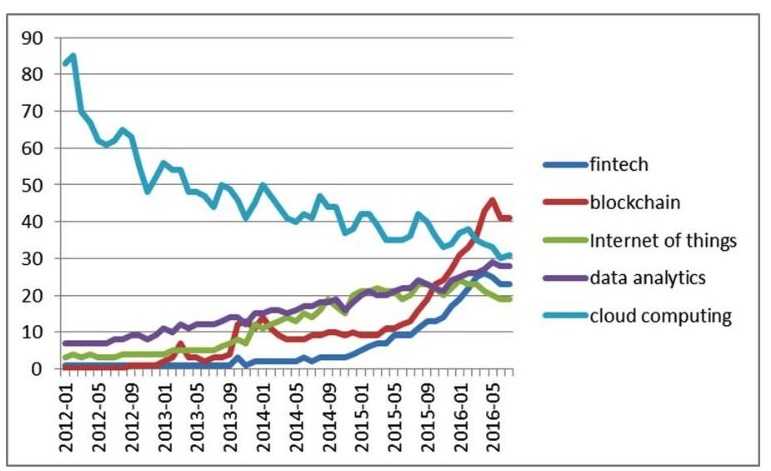As the International Blockchain Week draws to an end in Shanghai where uniting the different Blockchain technology networks was one of the central themes, and the announcements from large organizations exploring Blockchain gain momentum, an important question lingers - what would make Blockchain a viable option for an enterprise?
There has been a lot of recent interest in Blockchain, in fact it is approaching a peak on Gartner’s hype-cycle[1].
A recent report focused on enterprise Blockchain – “The Authoritative Guide to Blockchain for Enterprises” (“Guide”) illustrates this, with global interest in Blockchain eclipsing that in Fintech, the Internet of things, cloud computing and data analytics.[2]
 Source: The Definitive Guide to Blockchain for Enterprise - Google Trends
Source: The Definitive Guide to Blockchain for Enterprise - Google Trends
The reality is that most enterprises operate under some form of existing regulation, are either themselves an intermediary, or are working within an eco-system of value chain partners who are intermediaries. So, when one hears of Blockchain enabling decentralization and replacement of the central authority (replaced by the Blockchain itself) and disintermediation as a main thrust, it raises some concerns in addition to the opportunities it presents.
Organizations do realize that despite concerns, they cannot ignore Blockchain, so many are starting to explore Blockchain technology via a proof-of-concept. Before starting with a particular solution or selecting a vendor, however, it is critical that one assess the many considerations that come into play when selecting the best approach to Blockchain.
The fore-mentioned Guide provides some valuable insights. Firstly, it clears up the limited view of Blockchain as an avenue for mainly disintermediation by providing a more circumspect perspective on what Blockchain can do for enterprises. It also highlights various Blockchain eco-system participants (close to a 100 different companies including infrastructure, middleware, application, and consortium participants are mentioned in the context of their participation), and the Guide highlights key considerations enterprises need to make when exploring an approach to Blockchain.
When one speaks with enterprise decision makers, there are more questions about Blockchain than answers, illustrating the challenge with Blockchain when it comes to an enterprise – the fact is that there are a multitude of complex considerations.
When one speaks with enterprise decision makers, there are more questions about Blockchain than answers, illustrating the challenge with Blockchain when it comes to an enterprise – the fact is that there are a multitude of complex considerations. Some of these questions include: How will implementing Blockchain impact my business? How will it impact customer experience? What is the impact on my partner eco-system including my supply chain? How will I ensure privacy, security, and integrity? What type of use cases makes sense for my business? What platform is best suited for my needs, does it scale? How do I handle regulatory requirements? Where do I start? And the questions go on.
The answer, if there is one-answer, is that “it depends.” And as cliché as it sounds, it really is true. What this really means is that there is no one approach or “secret recipe” that would apply. Also, as the Guide points out, Blockchain doesn’t make sense for everyone and for many use cases. One has to go through a process of understanding the business, application and user needs, and take into considerations external factors such as the regulatory environment, etc. before determining the approach.
Blockchain doesn’t make sense for everyone and for many use cases.
So what are some of the things that are important to consider when deciding on Blockchain? According to The Authoritative Guide to Blockchain for Enterprises:
There are multiple considerations an enterprise needs to keep in mind in order to assess the best technology, platform, solution, and overall approach to their Blockchain implementation. These include:
- Identifying and managing risks of implementing Blockchain
- Determining the type of Blockchain (i.e. public vs private, etc.) that best meets your application and organizational needs
- Identifying the requirements to meet the needs of your application (i.e. scale, speed, cost, etc.)
- The skill-sets required to implement and maintain the Blockchain solution
- The strength of the particular Blockchain platform and supporting vendor ecosystem for middleware and applications
- Important Blockchain considerations are provided in the Guide, and some are summarized here:
- The need for business processes (“logic”) needs to be embedded in the Blockchain or not
- The degree of desired privacy in the Blockchain – this can help determine if a public Blockchain is viable or another solution is better suited
- Consensus and degree of scalability desired also have an impact on the Blockchain of choice
- Immutability and what this means for governance in the Blockchain – i.e., what happens if you need to change a rule in the future?
- The impact of moving an existing application from a centralized to a decentralized or distributed system can be very challenging – it may in fact be better to start with a new opportunity or process that is not as disruptive to the core business
- Once all of these are determined, you can decide the platform solution that best meets your needs
So where does one start? The 112-page Guide provides a practical step-by-step approach to implementing a Blockchain proof-of-concept for enterprises that cover all of the key factors.
--
About the Author
Dawood Khan is the founder of RedMobile, an innovative consultancy that is a trusted advisor to the world's leading public and private sector organizations. Mr. Khan has been providing Management, Innovation and Technology consulting services and advising executives and business leaders for over 23 years. He is an Industry expert in business and digital transformation, and use of smart, emerging and legacy technologies to innovatively meet business goals. He has worked with clients on developing mainstream innovation focused strategies, plans, business cases, get funding for capital projects, and develop technology investment and RoI assessments for clients in several different sectors including municipalities, retail, financial institutions, public safety, and telecom carriers to name a few.
Mr. Khan also helps organizations plan and execute their Digital Transformation journey through use of Design Thinking best practice to rapidly prototyping and iterate through the process of going from concept to proof-of-concept, and to commercial deployment of new services and products. His recent work includes planning and developing strategic roadmaps for large smart city initiatives, intelligent infrastructure asset planning, customer engagement using emerging tech (FI/FinTech), Retail digital customer experience design, public safety broadband network plan, funding and partnership models for DBOFM projects, proof-of-concept prototyping using IoT, Analytics, Cloud, and Mobile all as part of one application.
Mr. Khan has a Master of Electrical Engineering Degree from Columbia University, N.Y.; a Bachelor of Aerospace Engineering from Carleton University, and is a practicing CMC and Professional Engineer.
Twitter: @redmobileconsul
Linkedin: www.linkedin.com/company/red-mobile-co
Facebook: facebook.com/RedMobileCo
A version of this blog was first published here - https://www.linkedin.com/pulse/what-would-make-blockchain-viable-option-enterprises-dawood?trk=hp-feed-article-title-publish
Sources
[1] Gartner's 2016 Hype Cycle for Emerging Technologies Identifies Three Key Trends That Organizations Must Track to Gain Competitive Advantage http://www.gartner.com/newsroom/id/3412017
[2] “The Authoritative Guide to Blockchain for Enterprises”, September 2016
Interested in learning more about Blockchain? Join us in Toronto at the CMC-Global Conference on Oct 19-20!
